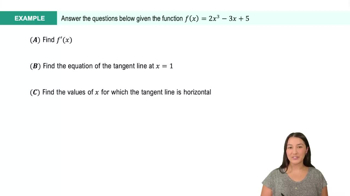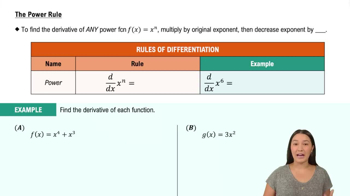Table of contents
- 0. Functions7h 52m
- Introduction to Functions16m
- Piecewise Functions10m
- Properties of Functions9m
- Common Functions1h 8m
- Transformations5m
- Combining Functions27m
- Exponent rules32m
- Exponential Functions28m
- Logarithmic Functions24m
- Properties of Logarithms34m
- Exponential & Logarithmic Equations35m
- Introduction to Trigonometric Functions38m
- Graphs of Trigonometric Functions44m
- Trigonometric Identities47m
- Inverse Trigonometric Functions48m
- 1. Limits and Continuity2h 2m
- 2. Intro to Derivatives1h 33m
- 3. Techniques of Differentiation3h 18m
- 4. Applications of Derivatives2h 38m
- 5. Graphical Applications of Derivatives6h 2m
- 6. Derivatives of Inverse, Exponential, & Logarithmic Functions2h 37m
- 7. Antiderivatives & Indefinite Integrals1h 26m
- 8. Definite Integrals4h 44m
- 9. Graphical Applications of Integrals2h 27m
- 10. Physics Applications of Integrals 2h 22m
3. Techniques of Differentiation
Basic Rules of Differentiation
Problem 46a
Textbook Question
Derivatives of products and quotients Find the derivative of the following functions by first expanding or simplifying the expression. Simplify your answers.
f(x) = (√x+1)(√x-1)
 Verified step by step guidance
Verified step by step guidance1
Step 1: Recognize that the function \( f(x) = (\sqrt{x} + 1)(\sqrt{x} - 1) \) is a product of two binomials. This expression can be expanded using the difference of squares formula, \((a+b)(a-b) = a^2 - b^2\).
Step 2: Apply the difference of squares formula to expand the expression: \((\sqrt{x} + 1)(\sqrt{x} - 1) = (\sqrt{x})^2 - 1^2\).
Step 3: Simplify the expanded expression: \((\sqrt{x})^2 = x\) and \(1^2 = 1\), so the expression becomes \(x - 1\).
Step 4: Now that the function is simplified to \(f(x) = x - 1\), find the derivative using basic differentiation rules. The derivative of \(x\) with respect to \(x\) is 1, and the derivative of a constant \(-1\) is 0.
Step 5: Combine the derivatives to find \(f'(x)\). Since the derivative of \(x - 1\) is \(1 - 0\), the derivative \(f'(x)\) is simply 1.
 Verified video answer for a similar problem:
Verified video answer for a similar problem:This video solution was recommended by our tutors as helpful for the problem above
Video duration:
2mPlay a video:
Was this helpful?
Key Concepts
Here are the essential concepts you must grasp in order to answer the question correctly.
Product Rule
The Product Rule is a fundamental principle in calculus used to find the derivative of the product of two functions. It states that if you have two functions, u(x) and v(x), the derivative of their product is given by f'(x) = u'v + uv'. This rule is essential when dealing with functions that are multiplied together, as it allows for the differentiation of each component function while maintaining their relationship.
Recommended video:
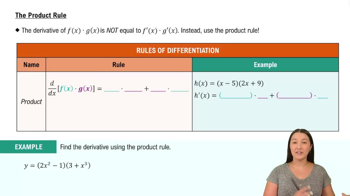
The Product Rule
Quotient Rule
The Quotient Rule is another important rule in calculus for finding the derivative of a quotient of two functions. If you have a function defined as f(x) = u(x)/v(x), the derivative is given by f'(x) = (u'v - uv')/v^2. This rule is crucial when differentiating functions that are expressed as a ratio, ensuring that both the numerator and denominator are appropriately accounted for in the differentiation process.
Recommended video:
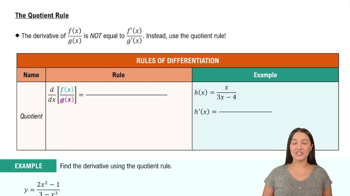
The Quotient Rule
Simplification of Expressions
Simplification of expressions involves rewriting a mathematical expression in a more manageable or understandable form. In the context of derivatives, simplifying an expression before differentiation can make the process easier and the results clearer. For example, expanding products or combining like terms can help eliminate complex fractions or roots, making it simpler to apply differentiation rules effectively.
Recommended video:
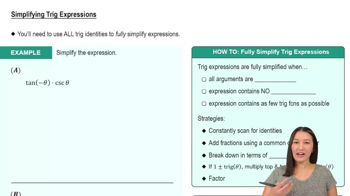
Simplifying Trig Expressions

 3:59m
3:59mWatch next
Master Derivatives of Linear Functions with a bite sized video explanation from Callie
Start learningRelated Videos
Related Practice



